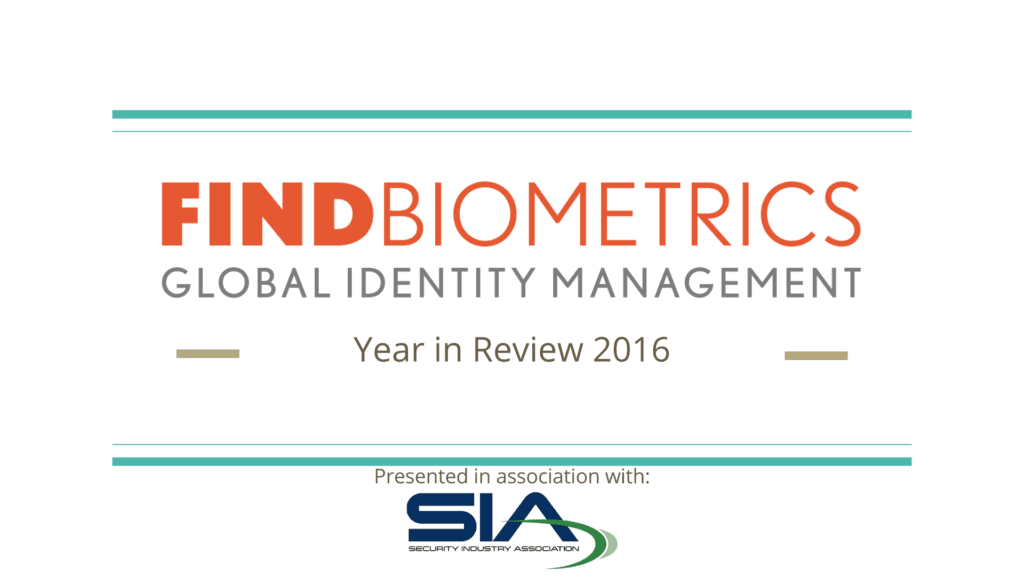After a year of dynamic change and massive growth for the biometrics and identity tech industries, and with CES having come to its conclusion on Sunday, we are now firmly entrenched in 2017. In December we conducted our 14th annual Year in Review survey, presented in association with SIA, and now it’s time to breakdown the results.
The FindBiometrics Year in Review is the longest-running survey of its kind. A staple of the biometrics industry, we are proud to engage you, our audience, year after year, to track the attitudes and outlook of the industry we live and breathe. In 2016, we collected responses from 165 professionals in biometrics and identity-related fields. The questions gauged attitudes about important modalities and areas of application, the role of privacy and public perception, industry maturity, and more.
Throughout the remainder of January we will be publishing our results with commentary and context from the most important news events of 2016. When appropriate, we will also compare the results to previous years in order to see how attitudes have shifted over time.
Welcome to the FindBiometrics Year in Review!
To start things off, let’s take a look at one of the broader questions on our 2016 survey:
How strongly do you agree with the following statement:
2016 was the first year biometrics truly felt like a mainstream technology
The question was formulated after observing pervasive trends in consumer electronics, mainstream media, and vertical markets. Specifically: throughout 2016 biometrics became commonplace in discourse around those three areas. Respondents were given the choice to strongly agree, agree, disagree, and strongly disagree. Here’s the breakdown of their answers:
Splitting it down the middle, an approximate 65 percent majority either agrees or strongly agrees with that statement, with the remaining 35 percent disagreeing.
Truly Mainstream
 In the news, ongoing conflict between ridesharing app companies and public safety advocates over the legislation of mandatory fingerprint-based background checks for taxi-service drivers shed a national spotlight on the difference between biometric and biographic data. Meanwhile, deployments of facial recognition technology continued to keep the privacy conversation loud and clear. And let’s not forget the continued pressure placed on large enterprises and government organizations to move beyond the password. With massive security breaches—like the 1 billion Yahoo! accounts revealed to have been compromised—highlighted how pressing the password problem truly is.
In the news, ongoing conflict between ridesharing app companies and public safety advocates over the legislation of mandatory fingerprint-based background checks for taxi-service drivers shed a national spotlight on the difference between biometric and biographic data. Meanwhile, deployments of facial recognition technology continued to keep the privacy conversation loud and clear. And let’s not forget the continued pressure placed on large enterprises and government organizations to move beyond the password. With massive security breaches—like the 1 billion Yahoo! accounts revealed to have been compromised—highlighted how pressing the password problem truly is.
Finally, within the industry we saw signs of increased maturity. Fingerprint sensor manufacturers, having proliferated the mobile device market, turned to expansion and innovation in 2016, moving in on the smart card market and making strides with the development and deployment of under-glass biometric technology. Biometrics became more accessible and along with that came a shift in demand, with major corporations (especially in the financial services sector) moving toward a multimodal attitude when it comes to user authentication. And, of course, the FIDO Alliance continued to gain momentum, certifying commercially available products and posturing itself to become the Bluetooth of authentication.
All of this adds up to an industry that is still active and exciting, but also firmly rooted in a strong foundation established over the last few years. Whereas in previous years biometric authentication felt like new and exciting technology, in 2016 it was easy to see it as just a regular part of our increasingly connected lives.
Already Mainstream
 For those who disagree, there is an argument to be made that biometrics already felt mainstream going into 2016. When we did our survey last year, about 72 percent of respondents said they used biometrics multiple times per day. Given that frequency of usage, it could be argued that biometrics were already mainstream going into 2016, even if they were not as uniformly available. Afterall, Touch ID, Apple’s fingerprint sensor, has been commercially available on iPhone models dating back to 2013.
For those who disagree, there is an argument to be made that biometrics already felt mainstream going into 2016. When we did our survey last year, about 72 percent of respondents said they used biometrics multiple times per day. Given that frequency of usage, it could be argued that biometrics were already mainstream going into 2016, even if they were not as uniformly available. Afterall, Touch ID, Apple’s fingerprint sensor, has been commercially available on iPhone models dating back to 2013.
Not Yet…
 And of course there is the argument that, as popular as biometrics have become, they don’t truly feel mainstream. Biometrics are still on track for complete smartphone ubiquity in 2018, but as it stands the consumer devices that leverage fingerprint, iris, face, and voice recognition, are still primarily measures of convenience. After all, if my fingerprint scan to access my Samsung Galaxy S7 can be bypassed by entering a four-digit PIN, then it is only truly as secure as that PIN. Furthermore, many biometrics integrations and deployments occurred late into last year, with biometric hardware still on its way to laptops and PCs (albeit which increasingly support biometric authentication through their operating systems).
And of course there is the argument that, as popular as biometrics have become, they don’t truly feel mainstream. Biometrics are still on track for complete smartphone ubiquity in 2018, but as it stands the consumer devices that leverage fingerprint, iris, face, and voice recognition, are still primarily measures of convenience. After all, if my fingerprint scan to access my Samsung Galaxy S7 can be bypassed by entering a four-digit PIN, then it is only truly as secure as that PIN. Furthermore, many biometrics integrations and deployments occurred late into last year, with biometric hardware still on its way to laptops and PCs (albeit which increasingly support biometric authentication through their operating systems).
So, there is an argument to be made that there is still growth to be made before biometrics truly feel like a mainstream technology. But as far as the majority of our survey respondents are concerned, we’re already there.
*
Stay posted to FindBiometrics throughout January as we continue to breakdown our Year in Review 2016 results.
The FindBiometrics Year in Review is presented in association with SIA and made possible by our sponsor: Tascent




Follow Us